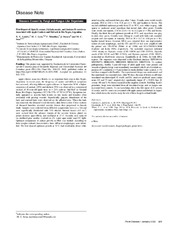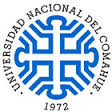- RDI Home
- →
- Facultad de Ciencias Agrarias
- →
- Artículos
- →
- View Item
JavaScript is disabled for your browser. Some features of this site may not work without it.
| dc.creator | Lódolo, X. V. | |
| dc.creator | Lutz, M. C. | |
| dc.creator | Mondino, P. | |
| dc.creator | Ousset, J. | |
| dc.creator | Sosa, M. C. | |
| dc.date | 2022-01 | |
| dc.date.accessioned | 2023-03-21T13:58:48Z | |
| dc.date.available | 2023-03-21T13:58:48Z | |
| dc.identifier.issn | 1943-7692 | es_ES |
| dc.identifier.uri | http://rdi.uncoma.edu.ar/handle/uncomaid/17044 | |
| dc.description.abstract | Apple (Malus domestica Borkh.) is an important fruit crop in Río Negro, Argentina. In recent years, the frequency of canker and dieback symptoms have increased affecting different apple cultivars. In September 2014, a higher occurrence of cankers (29%) and dieback (9%) was observed in a commercial orchard of 10-year-old apple trees (n=210) cv ʻItal Redʼ in General Roca, Río Negro, Argentina (39°2´36.73"S ? 67°32´44.55"W). Symptoms initially appeared as necrotic bark lesions on tree trunks and branches often associated with pruning wounds. Superficially, papyrus detachment of the bark and cracked bark were observed on the affected area. When the bark was removed, the diseased wood showed dark brown color. Cross sections of diseased branches revealed necrotic lesions that progress to branch death. Samples were collected from different symptomatic trees (n=30) and were superficially disinfected with 70% ethanol. Internal tissues (0.5 cm2) were excised from the advance margin of the necrotic lesions, plated on potato dextrose agar (PDA), and incubated at 22°C. Pycnidia were induced on sterilised pine needles overlaid on 2% water agar under near-UV light. Optimum temperature of culture growth on PDA was studied. According to their morpho-cultural characteristics, three different morphotypes were identified. The first, showed optimum growth at 30°C, had moderately dense white aerial mycelia and turned dark gray after 7 d. Conidia were ovoid, mostly aseptate, 20.8-25.6 × 8-11.4 µm (n=50) and hyaline to brown. The second, exhibited optimum growth from 25 to 30°C, was white to gray, with sparse to moderate aerial mycelium that turned dark olive green. Conidia were ovoid, 1-septate, 17.6-22.4 × 8.1-11.2 µm (n=50) and brown. Finally, the third showed optimum growth at 25°C, mycelium was grey to dark olive green. Conidia were oblong to ovoid with both ends rounded, aseptate and 1-septate at maturity, 20.8-24 × 11.2-14.4 µm (n=50), hyaline turned brown. Genomic DNA was extracted from one representative isolate of each morphotype and the ITS and EF1-α loci were amplified with the primer sets ITS1/ITS4 (White et al., 1990) and EF1-728F/EF1-986R (Carbone and Kohn, 1999), respectively. The nucleotide sequences indicated ≥99% identity to D. seriata (CBS 114796 and CBS 112555), D. mutila (CBS 302.36 and CBS 112553), and D. juglandis (CBS 188.87), reclassified as Dothiorella omnivora (Linaldeddu et al., 2016), for both DNA regions. The sequences were deposited in the GenBank database (MW596418, MW598375; MH665432, MK955889; MH665413, MK937229). To confirm pathogenicity, healthy 1-year-old twigs of adult apple trees were pruned and wounds of attached twigs immediately inoculated with 20 μL of conidial suspension (103 conidia.mL-1, n=9 per isolate) or sterile distilled water (control, n=9), and wrapped with Parafilm. The experimental design was randomized, and the experiment was repeated once. After 90 d, the area of lesion on all twigs inoculated was determined. D. mutila and Do. omnivora produced mean canker areas (65 and 73 mm2, respectively) significantly larger (p < 0.005) than D. seriata (48 mm2). No lesion occurred in the negative controls. Fulfilling Koch?s postulates, fungi were reisolated from all inoculated twigs and no fungus was recovered from controls. To our knowledge, this is the first report of D. seriata, D. mutila, and Do. omnivora associated with apple canker and dieback in Argentina, which shows the need of study the role of these fungi in orchard health. | es_ES |
| dc.format | application/pdf | es_ES |
| dc.format.extent | p .325 | es_ES |
| dc.language | eng | es_ES |
| dc.publisher | American Phytopathological Society | es_ES |
| dc.relation.uri | http://hdl.handle.net/11336/154157 | es_ES |
| dc.rights | Atribución-NoComercial-CompartirIgual 2.5 Argentina | es_ES |
| dc.rights.uri | https://creativecommons.org/licenses/by-nc-sa/2.5/ar/ | es_ES |
| dc.source | Plant Disease. Vol. 106, Núm. 1 (2022) | es_ES |
| dc.subject | Fungal pathogen | es_ES |
| dc.subject | Wood cankers | es_ES |
| dc.subject | Pome trees | es_ES |
| dc.subject.other | Ciencias Agrarias y Forestales | es_ES |
| dc.title | First report of diplodia seriata, diplodia mutila, and dothiorella omnivora associated with apple cankers and dieback in Rio Negro, Argentina | es_ES |
| dc.type | Articulo | es |
| dc.type | article | eu |
| dc.type | acceptedVersion | eu |
| dc.description.fil | Fil: Lódolo, X. V. Universidad Nacional del Comahue. Facultad de Ciencias Agrarias. Instituto de Biotecnología Agropecuaria del Comahue; Argentina. | es_ES |
| dc.description.fil | Fil: Lutz, M. C. Universidad Nacional del Comahue. Facultad de Ciencias Agrarias. Instituto de Biotecnología Agropecuaria del Comahue; Argentina. | es_ES |
| dc.description.fil | Fil: Lutz, M. C. Universidad Nacional del Comahue. Facultad de Ciencias Agrarias. Centro de Investigaciones en Toxicología Ambiental y Agrobiotecnología del Comahue; Argentina. | es_ES |
| dc.description.fil | Fil: Lutz, M. C. Consejo Nacional de Investigaciones Científicas y Técnicas; Argentina. | es_ES |
| dc.description.fil | Fil: Mondino, P. Universidad de la República; Uruguay. | es_ES |
| dc.description.fil | Fil: Ousset, J. Universidad Nacional del Comahue. Facultad de Ciencias Agrarias. Centro de Investigaciones en Toxicología Ambiental y Agrobiotecnología del Comahue; Argentina. | es_ES |
| dc.description.fil | Fil: Ousset, J. Universidad Nacional del Comahue. Facultad de Ciencias Agrarias. Instituto de Biotecnología Agropecuaria del Comahue; Argentina. | es_ES |
| dc.description.fil | Fil: Ousset, J. Consejo Nacional de Investigaciones Científicas y Técnicas; Argentina. | es_ES |
| dc.description.fil | Fil: Sosa, M. C. Universidad Nacional del Comahue. Facultad de Ciencias Agrarias. Departamento de Biología Aplicada; Argentina. | es_ES |
| dc.description.fil | Fil: Sosa, M. C. Universidad Nacional del Comahue. Facultad de Ciencias Agrarias. Centro de Investigaciones en Toxicología Ambiental y Agrobiotecnología del Comahue. Instituto de Biotecnología Agropecuaria del Comahue; Argentina. | es_ES |
| dc.description.fil | Fil: Sosa, M. C. Consejo Nacional de Investigaciones Científicas y Técnicas; Argentina. | es_ES |
| dc.cole | Artículos | es_ES |



